Light is an integral part of every plant’s life. Without light, the plants fail to receive energy for their daily activities. While growing a vegetable plant like garlic, understanding its light requirements is essential to keep it thriving.
Garlic plants need 6-8 hours of sunlight per day. It can remain healthy under indirect sunlight as long as the soil conditions are ideal, but a few hours of direct sun daily is crucial. Keeping them under a constant shade will make garlic susceptible to diseases like fungal disease and rot.
This guide will explain the different light conditions a garlic plant gets and what should be done if it doesn’t get the right light. If you want to know about everything, read till the end.
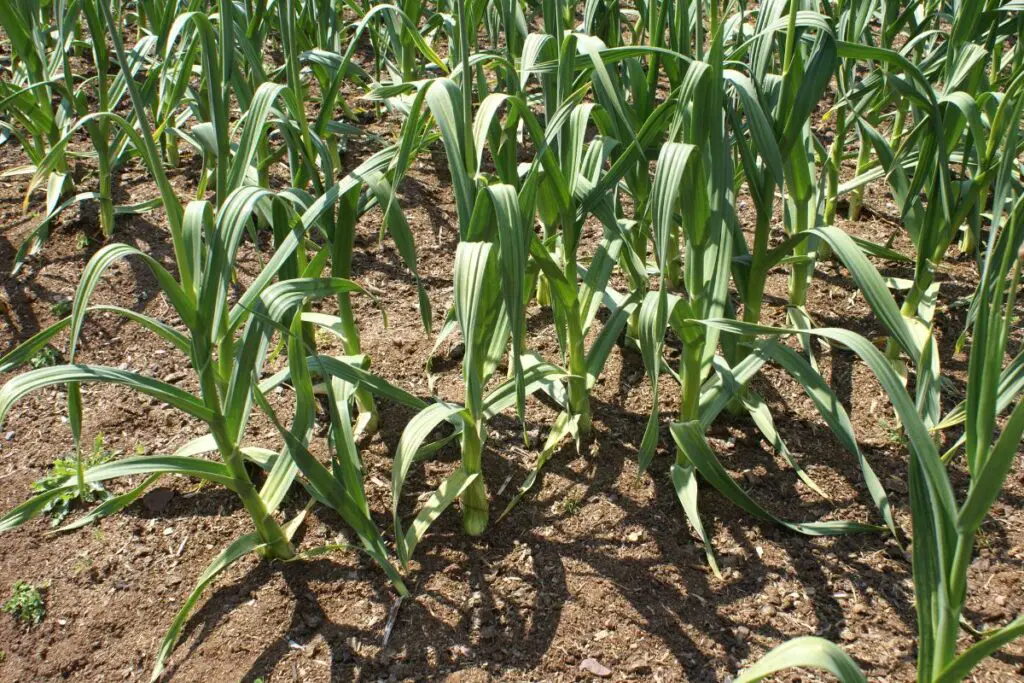
How many hours of sun does garlic need?
For an optimum growth speed and to reach its potential level, garlic plants require at least 6-8 hours of sunlight daily.
However, the plant will also grow well if it gets at least 3-4 hours of sunlight.
Not all types of garlic require daily 6-8 hours of sunlight.
Some can also grow with only 4 hours of sunlight.
On the other hand, some will need more sunlight.
Along with sunlight, the temperature is equally important.
Hardneck garlic can survive low temperatures.
But it would be best to plant Softneck garlic in warmer conditions.
Since the Softneck garlic is native to warmer climates, they need more sunlight than the Hardneck garlic plants.
Garlic will require at least some hours of full sun daily.
Otherwise, they will start rotting and become vulnerable to several diseases.
Does garlic need full sun?
Garlic plants can grow fast with adequate sunlight.
So it is crucial to see that they receive full sun for their overall growth and development.
As mentioned earlier, garlic requires full sun for 6 to 8 hours to grow at its optimum speed and level.
If garlic fails to receive full sun as per its need, you will have to make a few adjustments.
When a garlic plant doesn’t get enough full sun, the soil doesn’t dry out at its normal rate.
The garlic plants may be susceptible to certain diseases if the soil remains wet for a long time.
If you find that garlic is not getting enough sunlight at its location, consider certain soil changes.
Use well-drained loamy soil to prevent the accumulation of moisture around the roots.
Some studies have revealed that adding organic fertilizers like humic acid can increase the quality and harvest of garlic crops.
You can also apply organic fertilizers to improve the health of your garlic plants if they receive 6-8 hours of direct sunlight daily.
The more sunlight garlic gets, the more active it will become.
If it becomes energetic and active, it can consume the fertilizers and become healthier.
Wherever you decide to plant garlic, ensure that your garden gets adequate sunlight for 6-8 hours or 3-4 hours.
Can I grow garlic under indirect sunlight?
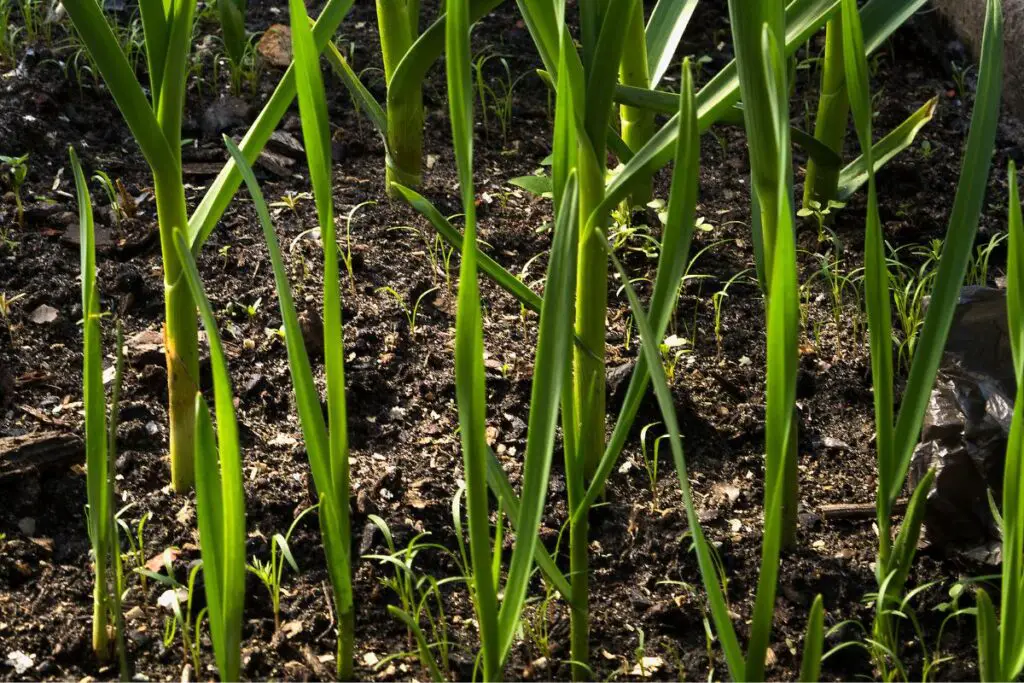
Garlic will thrive under indirect sunlight but not for the whole day.
If it gets at least 3-4 hours of direct sunlight daily, it can stay under the filtered sunlight for the rest of the day.
This direct sunlight is required for the proper functioning of photosynthesis.
The plant cannot receive the PAR for the photosynthesis process if it stays under indirect sunlight throughout the day.
As a result, it will affect the plant’s normal growth and development.
When garlic gets indirect sunlight, the light gets filtered or lands on another place and then bounces back to your plant.
If you let garlic have 3 hours of direct sunlight daily and then indirect sunlight for the rest of the day, that will be good.
At least, it will get PAR (photosynthetically active radiation).
Here also, soil adjustment is required.
Since the plant will not get direct sunlight for the rest of the day, the soil can take time to dry.
Plant the garlic plant in well-drained and loamy soil that supports fast drainage and prevents moisture accumulation around the roots.
Besides, confirm that the soil’s pH level should be within 6-7.
How do you differentiate between direct sun and indirect sun?
When you plant garlic, it is essential to find a sunny location.
But, how do you know if the spot receives direct sunlight or indirect sunlight?
It becomes confusing for beginners to distinguish between direct and indirect sunlight.
If you are a newbie gardener, follow the steps below to differentiate the light:
Extend your hand to the sunlight.
If the heat feels extreme and the shadow appears sharp, it is direct sunlight.
On the contrary, if the heat is mild and the shadow is soft, it is indirect sunlight.
Direct sunlight is when you are completely exposed to the full sun.
Indirect sunlight is the light filtered through shading nets and canopy or falls upon a surface and bounces back.
I hope, with this step, you will be able to distinguish between these two types of light.
Looking for gardening supplies? We have tested 100's of products before recommending them to you guys. Check out our best pick below:
| Image | Gardening Supplies | Best Price? |
|---|---|---|
 Top
Top Top
Top | Raised Garden Bed Kit | Check On Amazon |
 | XLUX Soil Moisture Meter, Plant Water Monitor, Soil Hygrometer Sensor for Gardening, Farming, Indoor and Outdoor Plants, No Batteries Required | No Results |
 Top
Top Top
Top | 82 Pcs Garden Tools Set and Extra Succulent Tools Set | Check On Amazon |
 | Joeys Garden Expandable Garden Hose with 8 Function Hose Nozzle, Lightweight Anti-Kink Flexible Garden Hoses, Extra Strength Fabric with Double Latex Core, (50 FT, Black) | No Results |
 Top
Top Top
Top | Dual Chamber Compost Tumbler | Check On Amazon |
 Top
Top Top
Top | Sunnyglade Plant Stakes | Check On Amazon |
 Top
Top Top
Top | Organic Cold Pressed Neem Seed Oil | Check On Amazon |
 Top
Top Top
Top | Mighty Mint Gallon :-Insect and Pest Control Peppermint Oil | Check On Amazon |
 Top
Top Top
Top | Scotts DiseaseEx Lawn Fungicide | Check On Amazon |
 Top
Top Top
Top | Jacks Classic 20-20-20 All Purpose Fertilizer | Check On Amazon |
 Top
Top Top
Top | 30,000 Seeds Pollinator Attracting Wildflower Mixture | Check On Amazon |
 Top
Top Top
Top | Survival Vegetable Seeds Garden Kit-Over 16,000 Seeds | Check On Amazon |
Will garlic survive in a shady location?
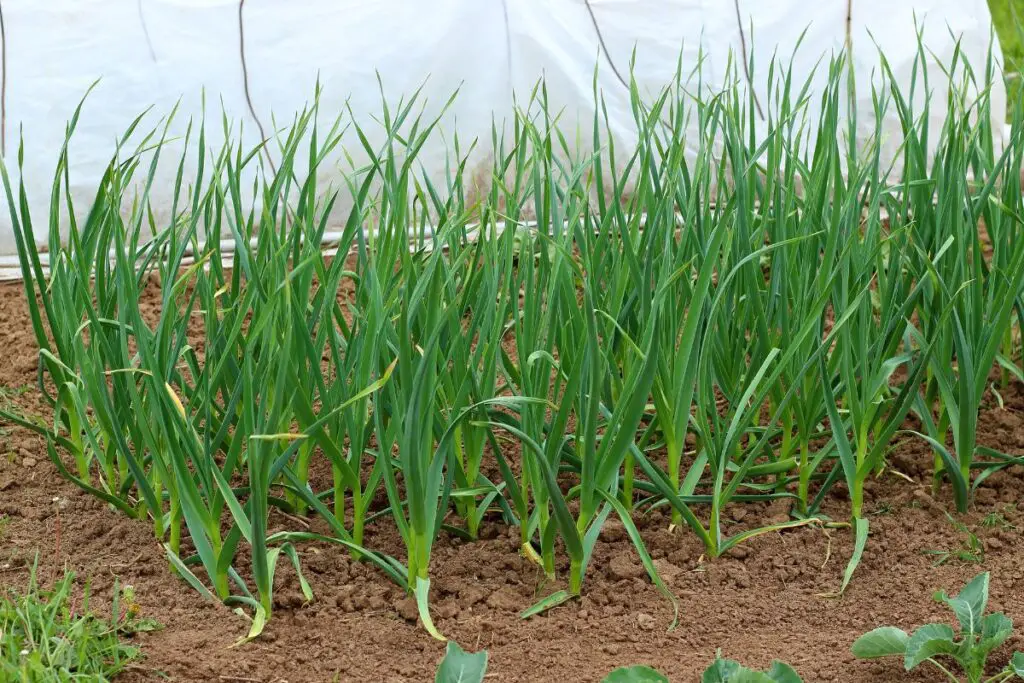
Garlic plants will require direct sunlight, if not for 6-8 hours, at least for 3-4 hours daily.
For getting the large garlic heads with the big, flavored garlic cloves, you must let the plants have sufficient sunlight per day.
If the plants don’t get enough sunlight, they will develop small garlic cloves, which won’t have that fine flavor.
The growth will weaken, and it won’t reach its maximum potential.
If you want to shade it to protect it from the sun’s scorching heat, you can do it during midday or afternoon when the sunlight is at its peak.
But don’t shade them for the entire day.
Let the plant have direct sunlight, at least in the morning.
However, garlic might not need shade because it loves full sun.
What happens if the garlic plant does not get enough sunlight?
The garlic plant won’t be able to survive or stay healthy if it doesn’t receive sufficient sunlight.
Without proper sunlight, the soil will remain wet around the roots, making the plant vulnerable to several diseases.
Below are some diseases which are the results of low light:
Pink Root
This fungal disease causes the roots to turn pink.
Over time, the roots become dark red, wither, and die.
White Rot
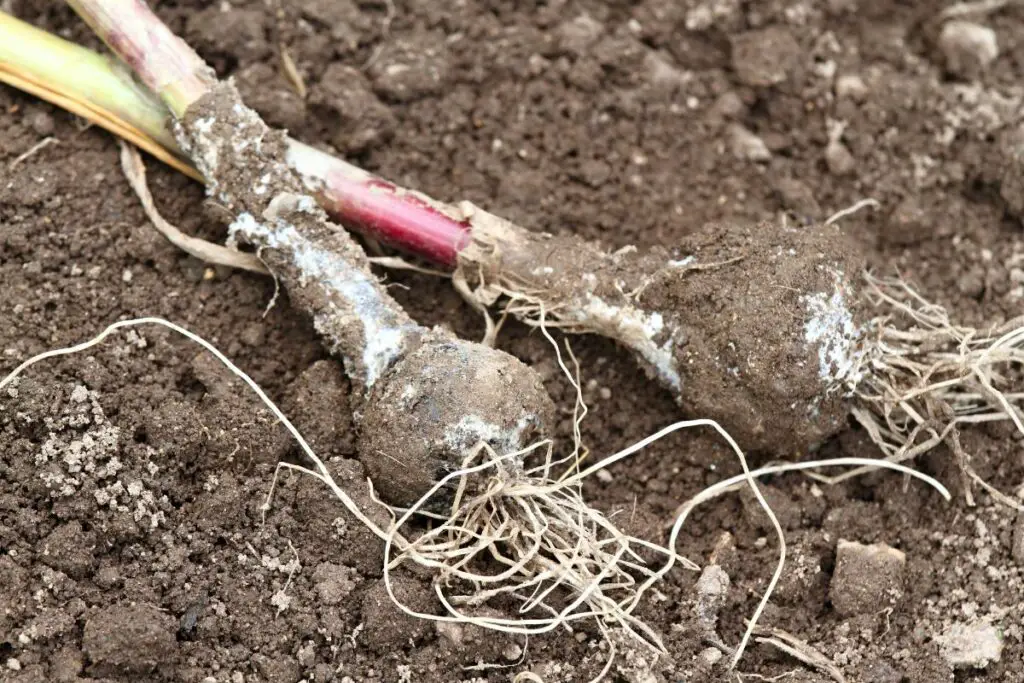
The pathogen of this disease decomposes the garlic leaves and roots.
Generally, this disease occurs when you plant infected seed cloves.
But it will also attack your garlic plant if it doesn’t need its required amount of sunlight.
Rust
Lack of proper sunlight will also lead to rust.
The older leaves first will develop red to orange lesions.
Then the newer leaves too will get affected.
Rust decreases the size of the garlic bulbs and affects the plant’s development.
It won’t stay if the plant has received direct sunlight daily for some hours.
Botrytis rot
This fungal growth enjoys prolonged damp conditions and will attack your garlic plant if it does not get enough sunlight and stays damp under the shade.
The plant’s stems will have a greyish fungal growth in dark and damp stems.
It usually happens if the garlic’s soil bed is damp for long during hot and humid weather.
Basal rot
Besides the lack of sunlight, basal rot also happens due to infestations and poor soil pH levels.
The soil remains damp due to a lack of sunlight for prolonged periods.
If your plant receives indirect sunlight, you need to adjust the soil conditions.
At that time, don’t forget to ensure the soil’s pH level.
Otherwise, you may invite the disease unknowingly.
The signs of this disease may be the same as White rot, but basal rot is less harmful than white rot.
To prevent these kinds of diseases, make sure to let garlic plants have adequate amounts of sunlight.
It must get direct sun for 6-8 hours daily, or at least 3-4 hours daily.
Will garlic tolerate too much sunlight?
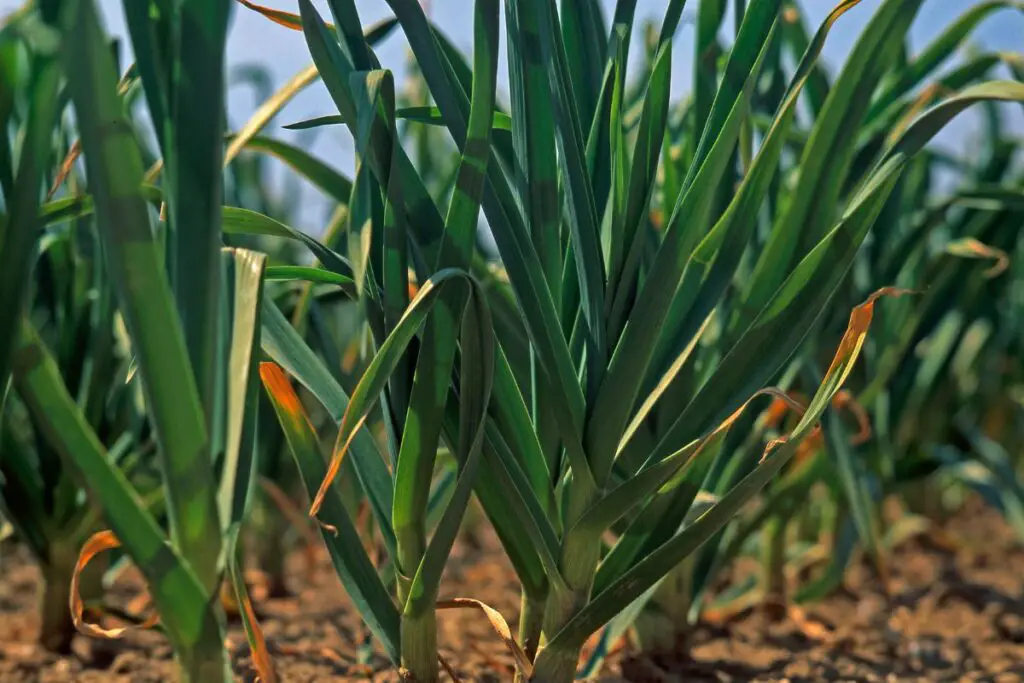
As I mentioned earlier, garlic must receive 6-8 hours of sunlight daily for adequate growth and development.
But what if the sunlight is too harsh or too much?
The summer gets too scorching in the warmer zones, and the sunlight is too harsh.
Fortunately, it will not affect the garlic too much because it flourishes under full sunlight.
If you have the Softneck garlic plants, they will love the sunshine more than the Hardneck variety.
Garlic remains unaffected under direct harsh sunlight if they are watered properly and planted over the right soil type.
As long as garlic gets the right watering and soil, it will consume as much sunlight as it needs.
There should be a balance between water and soil.
Though garlic doesn’t require too much water, the soil should not remain dry for long.
Since harsh sunlight can dry out the soil faster, check the soil frequently and water the plant when the soil is dry.
Which direction will give garlic plants sufficient sunlight?
Garlic will receive low light when you plant it in the wrong direction.
When you plan to plant garlic, first know which direction receives the most sunlight in your garden.
In most areas, it is always the southern or western direction that receives the maximum sunlight.
The eastern direction is also fine as it gets enough sunlight in the morning.
But it fades as the day progresses.
The northern direction gets the minimum amount of sunlight.
So, planting garlic in this direction may affect its growth and development.
However, these directions may vary depending on the hemisphere or zone you belong to, as the sunlight level will be different.
So, instead of just following this, examine the sunlight directions in your region first.
Check which direction of your garden gets maximum sunlight.
Plant garlic there.
How to water garlic plants?
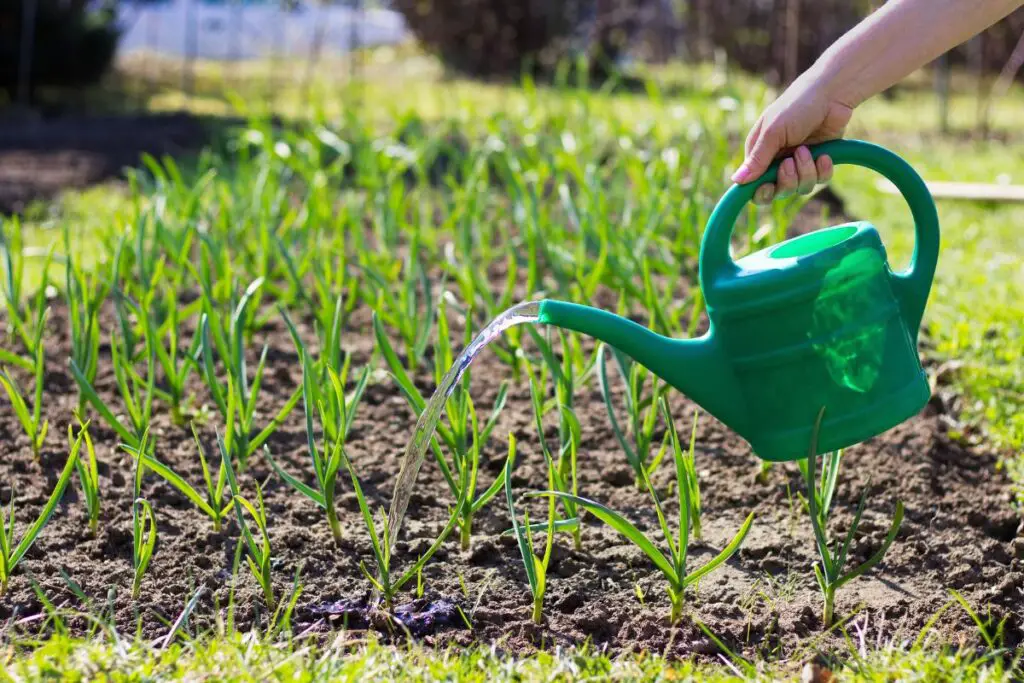
Since garlic plants stand under the sunlight for a long 6-8 hours, which is their need, it may occur that the soil has dried up faster.
So it is essential to understand the watering needs here.
Water garlic every 3-5 days, depending on the soil dryness.
Check the moisture level with a moisture meter if required.
Water the garlic plants every 7-10 days if your living region receives rain.
New garlic plants should receive enough water to soak up at least 6-8 inches of the soil.
Garlic will absorb plenty of sunlight with the correct watering technique and ideal soil.
Do not water the garlic too much in the winter, even if it is standing under the sunlight.
Since the soil bed will have mulches to hold the moisture, garlic will not get dehydrated.
What is the best soil for garlic?
When garlic doesn’t receive enough sunlight due to the wrong direction or cloudy weather, you need to make soil adjustments to increase the quality and nutrition.
Garlic grows best in soil that retains well and also drains well.
Use soil that is well-drained and loamy to prevent moisture accumulation.
Before planting garlic in your garden, check the soil structure, i.e., whether it is too clayey or sandy.
If the soil is too clayey, create a raised bed 12 inches deep.
For sandy soil, adding compost can improve the soil quality.
Garlic also enjoys nutritious soil.
You need to add organic matters like manure or compost during the spring or fall. Please add it before planting.
Garlic enjoys a pH level between 6 and 7.
Improper pH levels can result in basal rot.
So, you must check it before planting.
Final thoughts
Garlic requires 6-8 hours of sunlight per day. If it is not getting that many hours of sun, make sure that it gets at least 3-4 hours of sunlight. Remember, a few hours of direct sunlight is necessary. Otherwise, the plant won’t grow well.
Never shade your garlic plants. That would only result in diseases like white rot, pink root, or basal rot. Since the soil remains damp, the plant becomes susceptible to rotting.
Don’t worry much about sunburn because garlic plants don’t suffer much from excessive sunlight exposure. The more light they get, the healthier they remain. But don’t let the soil dry out, especially when garlic plants get full sun. Use well-drained loamy soil with 6-7 pH levels.
Reference: The Pennsylvania State University, Garlic Production for the Gardener, University of Massachusetts Amherst, Ohio State University Extension.
